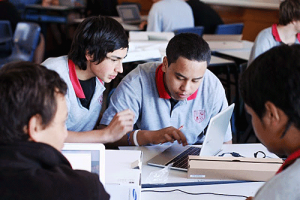Where exactly should we be going with online learning, safe environments and collaborative spaces for teachers and learners? What is the future of the tools, platforms and services that are available to our schools. I’ve spent a significant about of time working through why technology has failed to meet the needs of the learners and the teachers in our schools and the truth is that is has relatively little to do with the digital tools and services available. For our education system to truly embrace digital learning we need to give our learners, teachers and local authorities compelling reasons to invest their time, energy and resources. Our digital learning environment for the 21st century has to provide simple, credible and reliable solutions to the issues faced by our educators and their learners. We need a service, a product that meets our needs. We need a product we can believe in.

Apple believe in their products, they use them for their own business, Apple staff members use their computers, devices and services for their daily work. Google believe in their products: I’ve seen ChromeBooks in the hands of their engineers, Android devices operated by their reps and the whole organisation runs on Google Apps.

What does Apple offer it’s customers? In short, Apple makes your life easier, removes the hassles of technology and seamlessly moves your content to wherever you want it to be through the integrated Apple Eco system. People use Apple because it enables them to do more with out the hassle. And why do users go Google? My android phone syncs with my google apps, email, photos, etc. it’s all in the Google cloud. Google knows me. Google Now suggests websites, movies to me and even lets me know when it’s time to leave for an appointment based on current traffic. It solves my problems for me and helps me do things in new ways. It gives me time and removes the complications.
So why, in Education, have we learned nothing from this? Solve the problems that our learners and teachers face. A set of corporate business tools, no matter how good, are not focused on learning and teaching – they are not designed for the purpose so don’t expect teachers to use them if they add significantly to their already busy working lives. These are busy people, professional people, and if you can’t offer them something that improves their situation by meeting their needs, don’t waste their time.
For the last five years I’ve heard it said over and over that Curriculum for Excellence support would not provide large amounts of support materials for teachers. The reasons given: CfE is about teachers being free to produce material to support the needs of their learners; We only have a limited budget to produce some exemplification of small parts of the course; if we produce materials then everyone will use them and it will stifle development.

But, on the other hand producing high quality digital learning materials takes time and a set of skills that many of our teachers do not have. Our teachers are experts in learning and teaching and their particular specialisms. They are not digital media creators on the whole. So, how do we marry these two very differing perspectives? We need to look again at the digital tools we want to support learning and create a set of tools and content that really does meet the needs of our learners and teachers.
So, what could this look like? Imagine an environment, designed for any and all devices, which allows the class teacher to create drag-and-drop pathways/sequences of learning. This environment allows a teacher to quickly build a sequence of activity for learners: watch this Youtube video on climate change; discuss in groups and record your findings to this shared Google Doc, complete this quiz on Socrative etc. Notice that not all activity is online or technology based – recent studies have shown that we get the most impact from the use of technology in learning from a blended approach (Blended Learning Report May 2014, US DoE Meta Analysis 2010). The environment I’m describing enables teachers to quickly build learning – sometimes we need to do something quickly for the class tomorrow.

But the environment also allows the teacher to drill down and set the standards for the learning sequence: which Es&Os are contributed to, which assessment standards are being met, which unit outcomes. This can be achieved by tagging the whole learning sequence but also by tagging the individual elements of the sequence. And the benefit of this tagging? It allows the learner and the teacher to see more detailed analytics about progress, success and flags up possible need for greater teacher intervention to support the learner.

But the true beauty of such a system is that it allows teachers to share the materials/learning sequences they create. Let’s say you are a Physics Teacher and you are looking for a lesson on Space and Time. You search the environment and see four sequences tagged with Space and Time. You review these and then choose one to use. You click the Remix button the whole sequence is copied to your learning experience library and from there you can make changes to it. You decide that you want to use one of the Twig videos in Glow, you don’t have to go and separately find the material: a smart unified search engine allows you to locate learning material from the wide array of nationally procured material and from the open web. To add this new resource is just a drag and drop into your learning sequence, in the position you want, and all the previous elements of the learning sequence just shuffle into place.
Once you have your learning sequence you can allocate it to your learners’ class group. Your learners will receive a notification, if you wish, that this work is available to them. The environment might time lock some or all of the sequence depending on the choices you make as a teacher. You might keep the sequence unseen until class, you may allow your learners to complete work ahead of class or you could use this tool to flip your classroom.
Of course, the key to getting teachers to use such a system, is to have that system full of pre-prepared learning experiences and resources – linked to Curriculum for Excellence and new National Qualifications on launch. After all, what use is an iPodTouch without iTunes or a Kindle without the Amazon Bookstore? Preparing this content would be an opportunity for our national support agencies and other partners (universities, local authorities, commercial publishers etc) to step up their support for Scotland’s curriculum. If such a system begins with a significant number of courses/experiences for our learners and teachers then it will surely be successful.
Such a system doesn’t remove a teacher’s professionalism, it adds to it by providing the tools to do what teachers do best: adapting and customising learning to best meet the needs of their own learners. And such a system moves learners forward: providing a consumer focused set of tools which allow learners to know what they need to do to be successful and provides the support to allow this to happen.
And such an environment offers an exciting opportunity to link home, school, parents, teachers and learner together. Parental notification of progress/homework/opportunities for support could all be part of this environment. And clearly such an environment for learning needs to be deeply linked with data sources such as the SEEMIS system for learner/teacher/parent data and SQA systems (including Solar online assessment in order to offer assessment on demand for National Qualifications).
Platforms, similar to this, already exist, and can be used as models to inform development. OpenTapestry, Learning Score, Lin ed. But nothing yet ticks all the boxes we may require.
Education needs a Google search moment, an iPhone moment, a Facebook moment, a Twitter moment. A point of innovation that significantly impacts on how things are done, a product/service that reimagines what we can do with learning and changes it for the better. If that’s to happen we need the vision to provide these new tools to our educators rather than focusing too much on giving them what they had before that didn’t work.
If the technology we present to teachers and learners doesn’t make learning easier, more accessible and more engaging by providing the correct experience/assessment/content at the point of need then don’t bother – we’re busy people, don’t waste our time.


Jamiemorr2685
Technology for Learning? Focus on Learning and Teaching #newpost #scoteducation http://t.co/GEDy0BwL2Q
ScotEduBlogs
ScotEduBlogs: Technology for Learning? Focus on Learning and Teaching http://t.co/ApViIysqKX
johnjohnston
RT @charlie_love: Technology for Learning? It’s about content and platform.: Where exactly should we be going with online l… http://t.co/…
lorainespalding
RT @charlie_love: Technology for Learning? It’s about content and platform.: Where exactly should we be going with online l… http://t.co/…
Ian Nairn
Charlie – really like the ideas you have shared. In the US the charity based Gooru for Learning has been doing what you have suggested for a number of years. They encourage & support teachers around the world to create learning pathways which can then be easily reviewed and if useful copied, remixed and reused with your class. More can be found at http://about.goorulearning.org/ & a short video showing how it works can be found at http://about.goorulearning.org/community/teacher-toolkit
_BrightRed
RT @charlie_love: Some thoughts on Technology for Learning: Remix, reuse, tag and share http://t.co/yPRvdY1gy3 #cfe #technology #learning
robertd1981
RT @charlie_love: Some thoughts on Technology for Learning: Remix, reuse, tag and share http://t.co/JfMex85hWL #cfe #technology #learning
TonyRafferty2
RT @charlie_love: Technology for Learning? It’s about content and platform.: Where exactly should we be going with online l… http://t.co/…
hambudge
Technology for Learning? Focus on Learning and Teaching http://t.co/1aRRT6HyOk
bw_clark
RT @charlie_love: Some thoughts on Technology for Learning: Remix, reuse, tag and share http://t.co/yPRvdY1gy3 #cfe #technology #learning